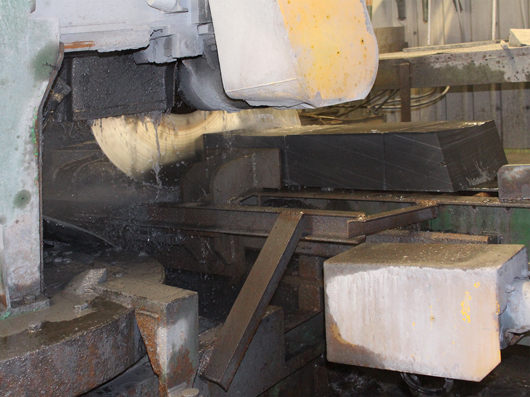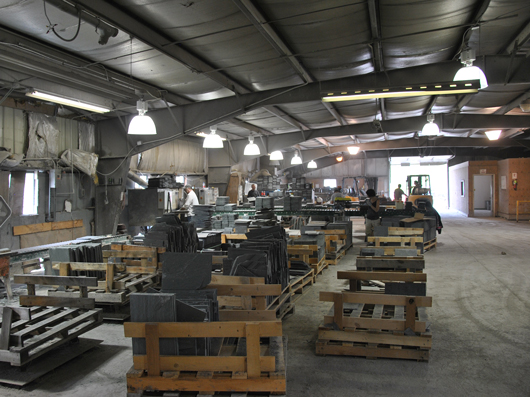|
Production of slate
The production design depends under what economic circumstances the company operates and which markets it serves. It can range from almost fully automated production seen in Spain and Germany to simple and somehow old-fashioned method. The following questions have to be answered:
Which products can be produced in which quantities and how is the investment in time?
What is the energy- and water demand?
How is the infrastructure?
What is the most efficient design of production and stock keeping?
An interim storage of blocks from the quarry can be necessary or economically more favourable.
One can sew the blocks close to the mine and transport these blocks to the slate mill for further processing or can concentrate the whole production at one place.
The large blocks are transported to the mill to saw them into "slate books" using disk saws. Slate books are slightly greater than the final size of the slate shingle because this addional material allowance is needed for the following trimming. If the slate books are not trimmed immediately aftwards, they have to be stored in waterfilled containers to keep the natural fresh moisture of the slate. This is very important to facilitate the trimming process and even within the short time from sawing of the slate books to the subsequent trimming process they are kept wet. Dry slates are difficult to split.
The finished slate undergoes quality control by means of a sound test simply by a small metal tool or by slightly striking two slate slabs to each other. But in a normally noisy production hall the test its not a real quality control in a strict sense so that it should be carried out in a separate hall. The slate is now ready for packaging which is normally done with wooden pallets which are commonly labeled with the logo of the company, the quality class (certificate) as well as format and number of shingles.
Pictures
Please move your mouse over thumbs to enlarge photographs
-


Fig. 1: Gained slate blocks are sawn to "slate books". Slate books are slightly greater than the final size of the slate shingle because this addional material allowance is needed for the following trimming. (Company Magog, Sauerland, Germany).
-


Fig. 2: Sewing of slate blocks which are slightly larger in length and width than the final slate shingle (Company Magog, Sauerland, Germany).
-


Fig. 3: Sewing of slate blocks which are slightly larger in length and width than the final slate shingle (Hilltop Slate, State New York, USA).
-


Fig. 4: Manual splitting of slate (Company Magog, Sauerland, Germany).
-


Fig. 5: Manual splitting of slate (Camara Slate, Fair Haven, State New York, USA).
-


Fig. 6: Trimming of rectangular slate shingles (Hilltop Slate, State New York, USA).
-


Fig. 7: Trimming of slate (no roofing slate) in Herbeumont (Belgium)
-


Fig. 8: Punching of slate (Hilltop Slate, State New York, USA).
-


Fig. 9: Automatic milling and punching on the right side (Company Magog, Sauerland, Germany).
-


Fig. 10: Slate mill (Company Hilltop Slate, State New York, USA).
-


Fig. 11: Quality control (Company Magog, Sauerland, Germany).
-


Fig. 12: Stock of different slates (Company Camara Slate, Fair Haven, State New York, USA).
-


Fig. 13: Production of crushed slate in Herbeumont (Belgium)
-


Fig. 14: Production of expanded slate (company Ulopor in Thuringia, Germany
-


Fig. 15: Rotary kiln for the production of expanded slate (company Ulopor in Thuringia, Germany
|

